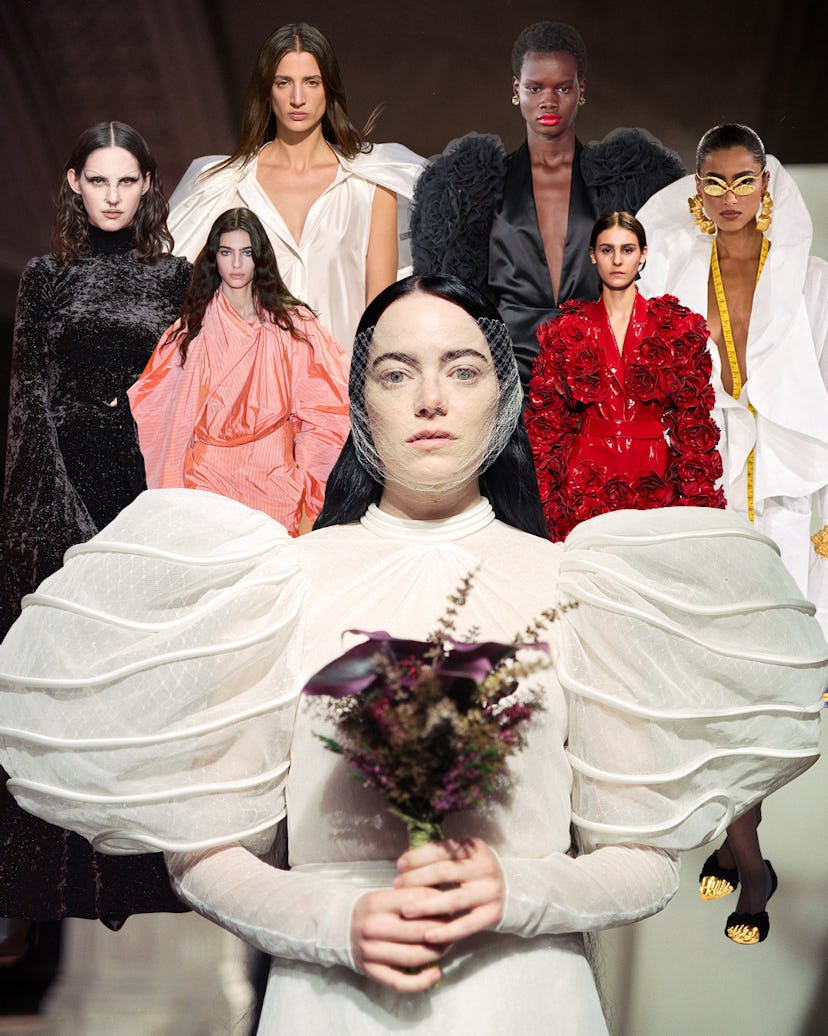One of the first things you might have noticed about Bella Baxter, Emma Stone’s delightful and seductive character in Yorgos Lanthimos’s Frankensteinian film Poor Things, is not her big blue eyes, her sudden bodily convulsions, or even her infantile speech, but, rather, the billowing confections that seemed to protrude from her shoulders. “It’s about the sleeve,” Lanthimos reportedly told the film’s costume designer, Holly Waddington, whose previous projects include Lady Macbeth and The Great. And that’s exactly what he got: really, really big sleeves.
The costumes in Poor Things were just the tip of the iceberg, however, in what had already been a big year for sleeves. An oft neglected part of one’s wardrobe, they’ve lately taken center stage on runways, on red carpets, in movies—and now on the streets. We started seeing them last year at the fall ready-to-wear shows: balloonlike ones at Thom Browne and trailing ones at Balenciaga. At the Met Gala in May, Kendall Jenner wore sequined Marc Jacobs sleeves so long they brushed the floor; Florence Pugh had a similarly dramatic look with a voluminous Valentino dress at the Academy Awards. In each case, the outfit was the sleeves.
Yorgos Lanthimos, Courtesy of Searchlight Pictures, © 2023 Searchlight Pictures, All Rights Reserved
For spring, the trend has evolved in even more dramatic, creative ways. At Rick Owens, the sleeves were severe, while at Stella McCartney, they were airy enough to catch the wind. Balenciaga went full wizard; Louis Vuitton and Khaite did old-school glamour; Schiaparelli achieved avant-garde proportions. Both Cristóbal Balenciaga and Elsa Schiaparelli played with sleeves throughout their careers; we’re simply seeing modern interpretations.
“It’s a way that designers can really show their individual style,” says Colleen Hill, the curator of costume and accessories at the museum at the Fashion Institute of Technology. It’s no coincidence that the museum began its 2024 programming with a show titled “Statement Sleeves,” featuring almost 80 pieces from its permanent collection that demonstrate how these design elements can be “signifiers of status, taste, and personality.”
Courtesy of Balmain
Courtesy of Stella McCartney
“They are not necessarily an easy thing to create,” Hill continues. “You can make them look really spectacular, but they’re not entirely functional. They just feel really fabulous. If you’re wearing a very simple cocktail dress and you have this big sleeve, it’s attention-grabbing.” In the age of Zoom and consuming culture through our phones, a statement sleeve is an easy way to stand out on a small screen. As Hill also pointed out, they’re oftentimes all you see of a garment when it’s hanging in your closet, meaning that, whether we realize it or not, we generally identify articles of clothing based on their sleeves.
Courtesy of Carolina Herrera
Courtesy of Louis Vuitton
To begin her research for the exhibition, Hill looked as far back as 5,000 years ago. She found a linen dress in London’s Petrie Museum of Egyptian Archaeology collection that has ruching, or gathering, over the shoulders for a decorative effect. The FIT collection doesn’t span millennia, but it does include detachable sleeves from the 1770s, which were secured to the bodice with ribbons, as well as a leg-of-mutton sleeve from the 1830s that is somewhat reminiscent of the costumes in Poor Things, which purposefully belong to no time or place.
“Part of our attraction to sleeves today is that there are so many out there,” Hill concludes. “There’s not one dominant style that works for your body. In fact, they draw attention to your shoulders and to your arms. So, in a way, they’re something that can be flattering on anyone.”
Courtesy of Balenciaga
Courtesy of Schiaparelli
This article was originally published on
